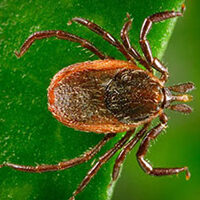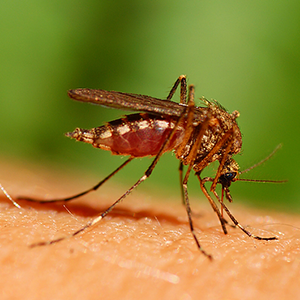Contact Us
Overview
Ticks are parasitic, blood-feeding arachnids (eight-legged invertebrate animals similar to spiders). They consume the blood of people and animals and feed by attaching to a host with their mouth parts.
Basics

Ticks feed on the blood of their host and will feed on mammals, birds and sometimes even reptiles or amphibians. They wait in tall grass and shrubs and grab onto potential hosts as they move through the brush.
Once a tick finds a host, it crawls to a good spot to feed and then buries its mouthparts in the host’s flesh. As it eats, its body slowly enlarges to accommodate the blood it’s eating. Ticks may feed from several minutes to several days.
Do Ticks Carry Disease?
In Washington state, ticks carry very few diseases and very few instances of disease are reported compared to other states, but they have been known to cause the following diseases in Washington.
Lyme Disease
Lyme disease is a bacterial disease transmitted to animals and humans by the bite of certain ticks infected with the bacterium Borrelia burgdorferi. In Washington, Lyme disease can be transmitted through the bite of a western blacklegged tick. These ticks live in forested or brushy areas of western Washington. This species of tick has not been found in eastern Washington. Symptoms include a bullseye-shaped rash and fatigue, headache and fever. Learn more.
Tick-borne Relapsing Fever
Tick-borne relapsing fever is a bacterial infection that causes recurring periods of fever and is transmitted by the soft tick, which picks up the bacteria from rodents. Periods of fever last two to seven days, disappear for four to 14 days, and then recur again. Between one and 12 cases occur in Washington each year.
Rocky Mountain Spotted Fever
Transmitted by the American dog tick or the Rocky Mountain wood tick, Rocky Mountain Spotted fever may cause fever, nausea, vomiting, muscle pain, lack of appetite, and severe headache. These symptoms are often accompanied by a rash, abdominal pain, joint pain and diarrhea. Zero to three cases occur in Washington each year.
Tick Paralysis
Tick paralysis is a progressive condition that typically starts with muscle weakness in the legs, loss of coordination, numbness and difficulty standing or walking. Paralysis symptoms progress to the abdomen, back and chest. If the tick is not removed, paralysis can extend to the chest muscle and lead to respiratory failure and death within 24 to 48 hours after symptoms start. Complete recovery is usually possible once the tick is removed. From 1990 to 2011, 12 cases of tick paralysis were reported.
Tularemia
Tularemia can be transmitted by different means; in Washington, it can be spread by the Rocky Mountain wood tick or the American dog tick. Symptoms include sudden fever, swollen lymph nodes, headache and a skin ulcer near the bite. One to 10 cases of tularemia are reported in Washington each year.
Anaplasmosis
Spread by western black-legged ticks, anaplasmosis may cause headache, fever, chills and muscle aches. No cases in humans have been reported in Washington state, but it has been diagnosed in dogs.
Babesiosis
Babesiosis typically causes chills, fatigue, fever, muscle pain and anemia. In Washington, Babesiosis is generally believed to be transmitted by the Western black-legged tick.
Other Diseases
In other parts of the United States, ticks also transmit: Borrelia mayonni, Borrelia miyamotoi, Bourbon virus, Colorado tick fever, Ehrlichiosis, Heartland virus, Powassan disease, Ricketssia parkeri rickettsiosis, STARI (Southern tick-associated rash illness), and 364D rickettsiosis. Visit the CDC’s Tickborne Diseases of the United States page to learn more.
Sources
Ticks | Washington State DOH | https://www.doh.wa.gov/Communi...
Recommendations
Ticks are most active in warmer months, so it’s especially important to be vigilant during those times.
How to Avoid Ticks
Ticks position themselves in brush and grasses, waiting to grab onto passing people or animals. Once they grab on, they crawl to a feeding spot on the host’s body and bury their mouthparts into the skin to eat blood.
Below are simple steps people can take to avoid picking up a tick when engaging in outdoor activities.
- Wear long pants with pant legs tucked into socks or boots and tuck in shirts (this helps prevent ticks from crawling into clothes and shoes)
- Use tick repellent like Permethrin or a product with 20 percent or more of DEET and always follow product instructions for safe use—see fact sheet for more repellent options
- Stay in the middle of trails when walking or hiking, rather than moving into the brush and avoid wooded and brushy areas
- After spending time outside, people should check for ticks on themselves, their children and their pets
- Bathe or shower as soon as possible (within two hours) after coming indoors
It’s also important to prevent ticks from coming indoors to find hosts. Here are a few ways to keep ticks from sneaking in on their own.
- Keep grass and shrubs around the home trimmed, remove yard waste like leaf litter and keep compost bins away from the house
- Install a tick barrier around the yard (like a three-foot wide bed of mulch or wood chips)
- Consider installing hardscape (patio, decking, etc.) around the home and limit shade—ticks don’t like crossing bright, sunny areas
- Place children’s play equipment in sand, gravel or wood chips where ticks are less likely to hide
See the fact sheet for more ideas.
How to Treat a Tick Bite
If a tick has already bitten, the best thing to do is promptly remove it.
- Use fine-tipped tweezers to grab the tick as close to the skin as possible (avoid using bare hands)
- Pull upward with even pressure, without twisting or jerking as this may cause the tick’s mouthparts to break off
- If the mouthparts do break off, remove them with tweezers and if they cannot be removed, leave the bit alone and allow the skin to heal
- Thoroughly disinfect after removal
- Make note of the date the tick was found and self-monitor for signs of illness, including fever, rash or flu-like symptoms
- If symptoms occur within several weeks after the bite, people should go to their doctor and let them know they’ve been bitten by a tick
Download the fact sheet for more information.
Tick Folklore
There is a lot of misinformation about the best ways to remove a tick. Do not use hot matches or coat the tick with oil, petroleum jelly, soap or nail polish to get the tick to detach. This typically doesn’t work and may irritate the tick which will cause it to release more saliva, which may in-turn, increase the likelihood of getting sick.
Sources
Ticks | Washington State DOH | https://www.doh.wa.gov/Communi...
Preventing Tick Bites on People | CDC | https://www.cdc.gov/lyme/prev/...

Bring It, Summer Pests!
Confront disease-carrying mosquitoes, ticks and mice during spring and summer months. Simple landscaping tricks and tips to protect home’s exterior.

Animals & Insects Program
Preventing the spread of disease from animals to humans is a public health responsibility.
